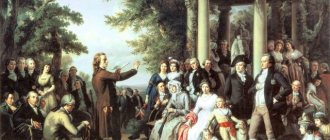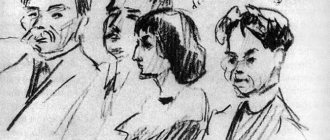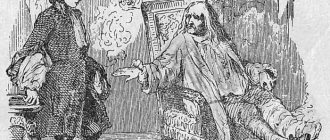General features of the development of Russian literature in the 18th century
Peter's reforms provoked, to a certain extent, the rejection of old Russian cultural traditions. However, in the field of literature they were not at all widespread. Although ancient Russian literature is rich in outstanding works, they have never been an object of mass interest even at the top of society. Many of them were completely forgotten by the end of the 17th century. Therefore, new Russian literature was created on a pan-European, ancient and, naturally, Christian basis.
The main literary genres were borrowed from Europe: “high” (ode, tragedy, epic) and “low” (comedy, fable, satire). In an ideological sense, the spirit of the Enlightenment is palpable in the best works of Russian literature of the century. Literary trends also corresponded to pan-European trends - first it was classicism, then sentimentalism.
Changes in language (partly introduced by official decisions, partly occurring naturally) required changes in the purely technical side of literary activity. Most of all, this was reflected in poetry, which moved from the syllabic system (which implies taking into account only the number of syllables, but not stress and their location) to the syllabic-tonic system (with the now familiar stanzas, iambs, trochees...). However, the style of prose also changed - the literary language began to gradually approach the natural.
The set of the most common literary themes has changed. Traditional fairy tales and epics (as well as derivatives from them) were no longer popular - Russian readers preferred to get acquainted with retellings from ancient literature, poems and “novels” dedicated to historical events, and love lyrics. In the times of Peter the Great, the genre of adventure work arose in Russian literature (in which all events were deliberately placed not in the “thirtieth kingdom”, but in real geography, and there were no supernatural motives).
The quantity and demand for purely religious literature has decreased. Although it continued to exist and even be promoted purposefully, it was largely replaced by journalism and controversy. Even Peter’s famous associate, priest Feofan Prokopovich, became known not for his religious creations, but for his journalistic and secular didactic works.
Development of Russian literature of the 18th century, its features
1. Russian literature in the 18th century. has gone through a significant path of ideological and artistic development. At the beginning of the century, Russian literature could rely only on the handwritten, largely religious literature of Ancient Rus', on folklore and on a few foreign sources. On this weak foundation, by the end of the century, the building of Russian literature was built, which in qualitative terms was not inferior to the literature of any of the great peoples of Europe and created wonderful examples of the art of words. Russian literature became European literature, while maintaining and strengthening its national identity.
2. Social, political content and ideological orientation are the distinctive features of literature of the 18th century. The sense of social responsibility drew the attention of writers to the essential aspects of reality and gave rise to a critical approach to the phenomena of life. Exposing the problems of public life and, above all, the plight of the vast majority of the country's population required insight, civic honesty and truthfulness from the writer. This, on the one hand, created the preconditions for the establishment of the realistic method in literature, and on the other, determined the predominant development of satirical genres. Satire is the cradle and source of Russian realism.
3. A satirical orientation was constantly present in the first significant literary movement of the century - classicism, starting with the work of A. Cantemir. This trend, oriented towards Western European cultural traditions, but which received a unique embodiment on Russian soil, despite its one-sidedness and limited artistic means, played a major role in the development of literature. Within the framework of classicism, genre, stylistic and figurative-semantic means of deeper and more meaningful methods of artistic expression were already being formed. Lomonosov carried out a reform of the Russian language and versification. Sumarokov gave the first real examples of those new genres (tragedy, comedy, satire, poem, fable, song, etc.) that will play an important role in the development of literature.
It should be emphasized that in the literary practice of Russian writers of the 18th century. the genres of classicism did not have the inviolability, the “canonicity” that was determined by the theory of classicism. “Minor” D.I. Fonvizina is a serious social and psychological drama, “pretending” to be a comedy; “Vadim Novgorodsky” Ya.B. Princess is a political tragedy, within the framework of which the most important moral and philosophical problems of a universal human nature are solved. “Overcoming the genre” by Russian comedy predetermined the appearance in Russian literature of the 19th century. drama as such. The same patterns appeared in the poetry of G.R. Derzhavin, who, while developing and improving odic creativity, at the same time introduced into it the principle of individual expressiveness.
4. In the last decades of the 18th century. We already have before us a motley and meaningful picture of Russian literature, in which three main directions can be distinguished: “outgoing” classicism, blossoming sentimentalism and emerging romanticism. The dialectical unity and at the same time diversity of these directions do not exclude elements of realism in the work of a number of writers. There were strong dramaturgy, combining specific historical and universal problems, civil and intimate lyrics, and significant successes in prose fiction, which would play a leading role in Russian literature of the 19th century. At the time of the development of sentimentalism in Russian literature, a sense of social responsibility was also preserved: in addition to the bold criticism of the foundations of Russian statehood in the dramaturgy of Fonvizin, in addition to the civic-pathetic sermon of Derzhavin, ideological aspirations were manifested with the greatest completeness and fearlessness in the work of A.N. Radishcheva.
5. Reached significant development during the 18th century. and the main material of literature is language. In the middle of the century, the classicist Lomonosov streamlined the cumbersome, largely confused and outdated legacy of the ancient Russian language, and at the end of the century, the sentimentalist Karamzin made the Russian language capable of expressing new ideas, concepts, tastes and themes determined by the social and cultural development of the nation. As a result of Karamzin's reform, the Russian language became receptive to new, more democratic transformations. In this sense, the work of Karamzin, like a number of other writers of the late 18th century, helped the formation and development of the comprehensive genius of literature of the 19th century. — A.S. Pushkin.
Valagin A.P. Question and answer: Russian literature. XVIII century. — Voronezh: “Native Speech”, 1995
The most prominent representatives of Russian literature of the 18th century
There were quite a lot of writers in Russia in the 18th century. Several magazines were published, where artistic and journalistic works were published. But not all the literature of that time was so original and high-quality as to leave any noticeable mark in the history of culture. In later times, no more than one and a half dozen authors actually enjoyed fame.
Authors of the first half of the 18th century
The first half of the 18th century was more characterized by the development of Russian poetry - mainly theoretical and didactic works were presented in prose. This was the period of formation of the Russian language, poetics and grammar, close to modern ones.
- VC. Trediakovsky (1703-1769) was a court poet and after his death was considered an example of bad taste in poetry. However, it was he who, as a theorist, developed the Russian syllabic-tonic system of versification. Trediakovsky even used his personal conflict with Lomonosov and Sumarokov for a more subtle study of Russian poetic theory. He is also known as an excellent translator of French works on Roman history.
- M.V. Lomonosov (1711-1765) was not only an encyclopedist, but also a poet and literary theorist. In general, he supported Trediakovsky’s poetic reform. Lomonosov is known as the author of solemn odes in honor of monarchs and outstanding events; the most famous of them is dedicated to the accession of Elizabeth Petrovna. The scientist also developed a new grammar and theory of oratory.
- A.P. Sumarokov (1717-1777), with his disputes with Lomonosov and Trediakovsky, also greatly advanced the theory of Russian poetry. As a writer, he tried many genres: he wrote odes, satires, elegies, songs, madrigals, epigrams, comic and tragic dramatic works. The most famous tragedies were “Khorev” and “Dimitri the Pretender”.
- HELL. Kantemir (1708-1744) represented the classical syllabic Russian school of versification (as he wrote even before the reform of Trediakovsky and Lomonosov). His works were published in Russia after the author's death. Kantemir is the first Russian satirist. His most famous satire is “On those who blaspheme the doctrine.”
In the second half of the century, based on the reforms of Trediakovsky and Lomonosov, in the context of the development of theater and publishing, the number of writers increased. But the main thing is that the number of genres popular with the public and represented by outstanding works has also increased.
Writers of the second half of the 18th century
The period of the reign of Elizabeth Petrovna and especially Catherine II and Paul I was characterized by the rapid development of drama and prose. If earlier poetry dominated Russian literature, then by the end of the 18th century this ceased.
- G.R. Derzhavin (1743-1816) became perhaps the most famous Russian poet of the century. Derzhavin brought Lomonosov's poetic classicism to perfection. He gained fame thanks to the ode “Felitsa”, dedicated to Catherine II. Derzhavin is also known as the author of the poems “Waterfall”, “To Rulers and Judges”, and his “Monument” was later used in his work by A.S. Pushkin.
- I WOULD. Knyazhnin (1740-1791) reached heights in dramaturgy in the spirit of classicism. At the same time, he preferred to take his stories from Russian history. The most famous works of the playwright are “Vadim Novgorodsky”, “Vladimir and Yaropolk”.
- DI. Fonvizin (1745-1792) worked in a different genre - he is the founder of Russian everyday comedy. His most famous work is the satirical play “The Minor.” Fonvizin was also the author of satirical poems.
- MM. Kheraskov (1733-1807) with his work represents the transitional stage from classicism to sentimentalism. Many genres are represented in his work, but epic poems (Rossiada, The Battle of Chesme, Vladimir the Reborn) and didactic novels (Numa, or Prosperous Rome, Cadmus and Harmony) on Russian and ancient themes predominate.
- N.P. Osipov (1751-1799) is known as the author of didactic articles and stories, publisher and translator, but especially as the author of the poem “Virgil’s Aeneid, Turned Inside Out.” The appearance of this work marked the refusal of Russian literature from the unconditional admiration for ancient models characteristic of classicism.
- A.N. Radishchev (1749-1802) is known as the author of “Journey from St. Petersburg to Moscow” - a tough, essentially journalistic work that reveals the dark sides of Russian life of that time. However, Radishchev also owns philosophical treatises and works of diary style. In the 19th century, he was highly valued by literary authorities as one of the examples of Russian style.
The activity as a writer N.M. can also be attributed to the 18th century. Karamzin (1766-1846). He became a “historian of the Russian state” in the 19th century, and his most famous story, “Poor Liza,” was published in 1792.
In the 18th century, female writers first showed themselves in Russia. But in most cases they were forced to publish under pseudonyms, and in terms of level they could not yet equal male authors. Women's literature is represented mainly by short poetic works and translations.
Literature. Grade 9 (part 1) Russian literature of the 18th century
| Russian literature of the 18th century At the beginning of the 18th century, during the Peter the Great era, Russia began to develop rapidly thanks to transformations in all areas of state and cultural life. These transformations led to the centralization of autocratic statehood and themselves contributed to it. At this time, Russia's independence strengthened, its military power increased, its cultural rapprochement with European countries occurred, and its influence on the European arena increased. Widely using the achievements of domestic and world science, culture, technology, industry, education, Peter I, with his reforms, opened new paths for Russian literature. Despite the fact that the movement of Russia slowed down after the death of Peter the Great, Russian society achieved enormous results in the field of culture and education in the 18th century. The Russian monarchs, especially Peter I and Catherine II, clearly understood that it was possible to move the country forward, destroy inert patriarchal orders, long-standing superstitions that created obstacles to the growth of material values and new social relations, and to establish new secular state and moral norms and concepts only with the help of education, enlightenment, culture, press. In this regard, literature has received exceptional attention. Under these conditions, various layers of Russian society received the opportunity for broad intellectual and artistic activity: Moscow University, secondary schools and vocational schools were opened, a new calendar was introduced, the first Russian newspaper was founded, the Academy of Sciences, the Academy of Arts, the Free Economic Society, the first permanent Russian were established. theater. Society was given the opportunity to express their opinions and criticize the affairs of the government, nobles and dignitaries. Russian literature of the 18th century inherited from ancient Russian literature a high understanding of the art of words and the mission of the writer, the powerful educational impact of the book on society, on the minds and feelings of fellow citizens. She gave these historically established features new forms, using the possibilities of classicism and the Enlightenment. The main idea of the development of literature in the era of classicism was the pathos of state building and transformation. Therefore, high civil-patriotic poetry and accusatory and satirical criticism of the vices of society and the state, circumstances and people who hindered progress came to the fore in literature. The central genre of high civic poetry was the ode. The critical direction was represented by the genres of high satire, close to ode, fable and everyday comedy of manners. These main directions in the development of literature were determined at the beginning of the century. In the first third of the century, classicism was formed, the birth of which was facilitated by one of the highest hierarchs of the Orthodox Church - the writer Feofan Prokopovich. The founders of classicism were A. D. Kantemir, V. K. Trediakovsky and M. V. Lomonosov. Besides them, the largest writer, whose work began in the first half of the 18th century, was A.P. Sumarokov. In the second half of the 18th century, from about the 1760s, a new period began in literature. At this time, new genres appeared: prose novel, story, comic opera and “tear drama”. As social contradictions deepened, satire became more widespread. To soften her impact on society, Catherine II herself became the secret publisher of the satirical magazine “Everything.” The Empress wanted to reduce the role of public satire and increase the importance of government satire, serving the political interests of the monarchy. She invited writers and publishers to follow her example. Russian society took advantage of this. Several satirical magazines immediately appeared in Russia (“Both this and that,” “Mixture,” “Hellish Mail,” “Drone,” “Neither this nor that in prose and verse,” “Podenshchina”). The most radical magazines that fought with Catherine’s “Everything and Everything” were the magazines of the outstanding Russian educator N.I. Novikov - “Drone” and “Painter”. “Message to my servants Shumilov, Vanka and Petrushka”, “The Fox the Executor”) and comedies (“Corion”, “Brigadier”, “Undergrown”) by D. I. Fonvizin, in the comedies of Ya. B. Knyazhnin (“Boaster” , “Weirdos”), in the comedy “Sneak” by V.V. Kapnist, in the prose and comedies of I.A. Krylov (“Pranksters”, “Trumph, or Podschipa” and written at the beginning of the 19th century “Fashion Shop” and “ A lesson for daughters"). At the same time, interest in large, high forms of literature does not cool down. After the tragedies of A. P. Sumarokov in the last quarter of the 18th century, Ya. B. Knyazhnin (“Rosslav”, “Vadim Novgorodsky”) and other playwrights, for example N. P. Nikolev (“Sorena and Zamir”) turned to this genre. In the second half of the 18th century, the genre system of classicism began to fetter the creative thought of writers, and they tried to destroy and reform it. The heroic poem, characteristic of Kantemir (“Petriad”), Lomonosov (“Peter the Great”), Sumarokov (“Dimitriada”), now fades into the background. The last attempt in this genre - “Rossiyada” by M. M. Kheraskov - was not crowned with success. Since then, the favorite genres of Russian authors have become the “irocomic” poem, the humorous poem and the comic opera, in which the genre of the heroic poem was ironically re-imagined (“The Ombre Player”, “Elisha, or the Irritated Bacchus” by V. I. Maykov; “Darling” by I. F. Bogdanovich). The same tendencies of exhaustion of classicism as a literary movement are noticeable in the work of the greatest poet of the 18th century G. R. Derzhavin, who updated the principles of classicism and preceded the emergence of romanticism. At the end of the 18th century, a new literary trend emerged in literature - sentimentalism. He had a strong influence on A. N. Radishchev, the greatest Russian thinker and angry writer, whose feelings were outraged by the people's troubles, the oppressed position of the peasants and the common Russian people in general. His main work, “Journey from St. Petersburg to Moscow,” was written in the “travel” genre, beloved by sentimentalists, and was caused by emotional shock from the pictures of injustice and lawlessness he saw. This “sensitivity,” this concern of the heart, is extremely close to sentimentalists. - poet, prose writer, publicist, journalist, “our last chronicler and first historian,” according to Pushkin, and reformer of the Russian literary language. Many poems, ballads and stories brought him all-Russian fame. His greatest achievements are associated with such works as “Letters of a Russian Traveler”, the story “Poor Liza”, “History of the Russian State”, as well as with the transformation of the literary language. Karamzin outlined and implemented a reform, thanks to which the gap between the oral, spoken and written, book language of Russian society was eliminated. Karamzin wanted the Russian literary language to express new concepts and ideas that developed in the 18th century as clearly and accurately as the French language spoken by Russian educated society. Karamzin’s closest ally was I. I. Dmitriev, the author of popular historical and patriotic works, songs, romances, satirical tales and fables (“Ermak”, “Liberation of Moscow”, “The Gray Dove is Moaning...”, “Alien Talk”, “Fashionable Wife” " and etc.). The principles of sentimentalism were talentedly embodied in his songs in the folk spirit by Yu. A. Neledinsky-Meletsky, who owns several songs (for example, “I’ll go out to the river ...”) that have survived in the song repertoire to this day. Russian literature of the 18th century, in its rapid development, provided for the future great achievements of the art of speech that followed in the 19th century. She almost caught up with leading European literature and was able to “... become on par with the century in enlightenment.” Classicism Classicism - exemplary) is an artistic style and aesthetic direction in European literature and art of the 17th - early 18th centuries, one of the most important features of which was the appeal to the images of ancient literature and art as an ideal aesthetic standard. The poetics of classicism began to take shape in the late Renaissance in Italy and was formed in the 17th century in France. Classicists consider strict adherence to unshakable rules, which are drawn from the ancient poetics of Aristotle and Horace, to be an indispensable condition. The aesthetics of classicism establishes a strict hierarchy of genres: “high” genres - tragedy, epic, ode; “low” genres - comedy, satire, fable. In France, “low” genres—fable (J. Lafontaine) and satire (N. Boileau)—reached special development. Moliere's comedies ceased to be a “low” genre; his best plays were called high comedy. After the French Revolution, classicism fell into decline. In Russia, classicism originated in the second quarter of the 18th century (A. D. Kantemir, V. K. Trediakovsky, M. V. Lomonosov, etc.). It is characterized by a satirical orientation - satire, fable, comedy. National historical themes prevail over ancient ones (A. P. Sumarokov, Ya. B. Knyazhnin); the level of development of the ode is high (M. V. Lomonosov, G. R. Derzhavin), the genre of military-patriotic poem occupies a large place. At that time, aesthetic norms played a positive role - clarity and precision of the artistic form was achieved. At the beginning of the 19th century, the canons of classicism, requiring the law of three unities - time, place, action, began to interfere with the development of realistic art. A. S. Pushkin, A. S. Griboyedov, V. G. Belinsky criticized the “rules” of classicism.
century: the work of a number of writers of the last decades of the 18th century (to a greater or lesser extent, in one form or another) became one of the organic components in the development of the living literary process of the beginning of the next century. These writers include, first of all, Fonvizin, Radishchev, Derzhavin, Karamzin, Krylov. The literature of the new century included not only those works that were written during this period, but also those that were created earlier.
|
The significance of Russian literature of the 18th century
In the 18th century, Russian literature had not yet reached the level it reached in the “golden” age. However, the “golden age” would have been impossible without the reforms of Lomonosov and Trediakovsky and the creative efforts of Fonvizin, Derzhavin and Osipov.
In the 18th century, the foundations were laid for the development of Russian literature on a new basis - common with all of Europe. Since it was a time of “trial and error,” many authors of this era seemed downright outdated and even ridiculous at later stages of the development of literature (Pushkin, for example, already criticized Derzhavin). But this does not mean that it was not of particular value - the analysis of these errors helped to move Russian literature further. In this regard, it is significant that N.M. Karamzin, as a mature writer, led the next “language revolution”, uniting around himself a new generation of literary innovators and predetermining the future flourishing of the literature of the “golden age”.
Choose an answer
Read more >>








